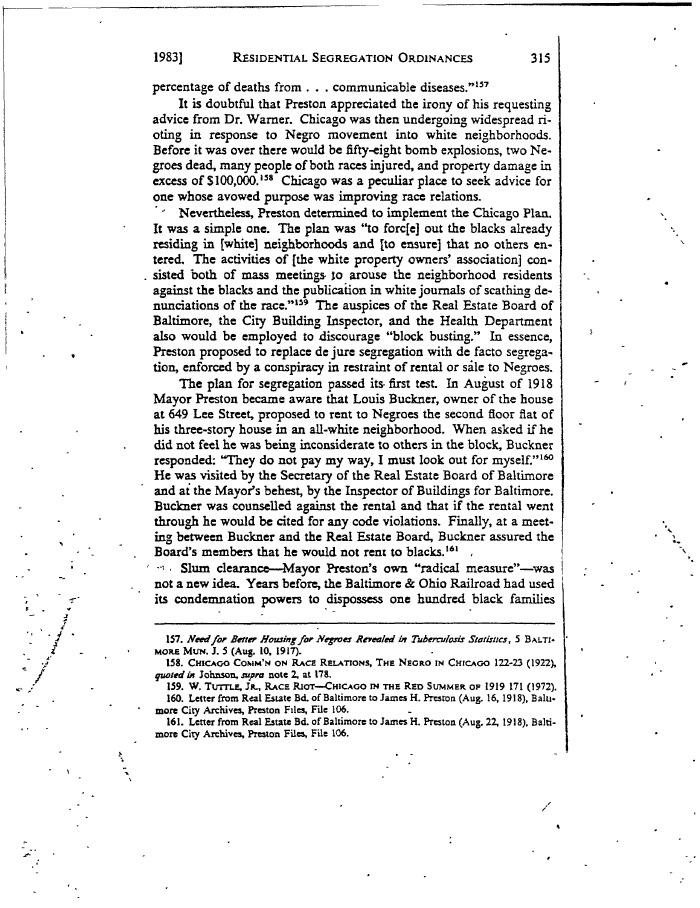 |
||||
|
Garrett Power, Apartheid Baltimore Style: The Residential Segregation Ordinances of 1910-1913, Maryland Law Review, 42 (1983) , Image No: 28 Enlarge and print image (67K) << PREVIOUS NEXT >> |
 |
||||
|
Garrett Power, Apartheid Baltimore Style: The Residential Segregation Ordinances of 1910-1913, Maryland Law Review, 42 (1983) , Image No: 28 Enlarge and print image (67K) << PREVIOUS NEXT >> |
| 1983] RESIDENTIAL SEGREGATION ORDINANCES 315 J V percentage of deaths from . . . communicable diseases."157 It is doubtful that Preston appreciated the irony of his requesting advice from Dr. Warner. Chicago was then undergoing widespread ri- oting in response to Negro movement into white neighborhoods. Before it was over there would be fifty-eight bomb explosions, two Ne- groes dead, many people of both races injured, and property damage in excess of $100,000.138 Chicago was a peculiar place to seek advice for one whose avowed purpose was improving race relations. Nevertheless, Preston determined to implement the Chicago Plan. It was a simple one. The plan was "to forc[e] out the blacks already residing in [white] neighborhoods and [to ensure] that no others en- tered. The activities of [the white property owners' association] con- sisted both of mass meetings- to arouse the neighborhood residents against the blacks and the publication in white journals of scathing de- nunciations of the race.139 The auspices of the Real Estate Board of Baltimore, the City Building Inspector, and the Health Department also would be employed to discourage "block busting," In essence, Preston proposed to replace de jure segregation with de facto segrega- tion, enforced by a conspiracy in restraint of rental or sale to Negroes. The plan for segregation passed its- first test. In August of 1918 Mayor Preston became aware that Louis Buckner, owner of the house at 649 Lee Street, proposed to rent to Negroes the second floor flat of his three-story house in an all-white neighborhood. When asked if he did not feel he was being inconsiderate to others in the block, Buckner responded: "They do not pay my way, I must look out for myself.160 He was visited by the Secretary of the Real Estate Board of Baltimore and at the Mayor's behest, by the Inspector of Buildings for Baltimore. Buckner was counselled against the rental and that if the rental went through he would be cited for any code violations. Finally, at a meet- ing between Buckner and the Real Estate Board, Buckner assured the Board's members that he would not rent to blacks.161 , Slum clearance—Mayor Preston's own "radical measure"—was not a new idea. Years before, the Baltimore & Ohio Railroad had used its condemnation powers to dispossess one hundred black families 157. Need for Better Housing for Negroes Revealed in Tuberculosis Statistics, 5 BALTI- MORE MUN. J. 5 (Aug. 10, 1917). 158. CHICAGO COMM'N ON RACE RELATIONS, THE NEGRO IN CHICAGO 122-23 (1922), quoted in Johnson, supra note Z at 178. 159. W. TUTTLE, JR., RACE RIOT—CHICAGO IN THE RED SUMMER OF 1919 171 (1972). 160. Letter from R«al Estate Bd. of Baltimore to James H. Preston (Aug. 16, 1918), Bain- more City Archives, Preston Files, File 106. 161. Letter from Real Estate Bd. of Baltimore to James H. Preston (Aug. 22, 1918), Balti- more City Archives, Preston Files, File 106. |